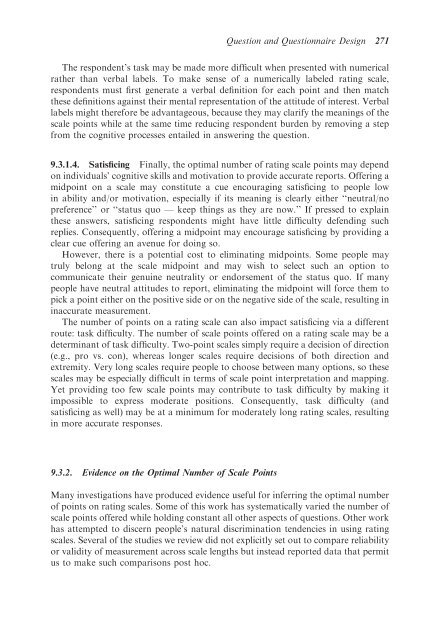Question and Questionnaire Design - Stanford University
Question and Questionnaire Design - Stanford University
Question and Questionnaire Design - Stanford University
You also want an ePaper? Increase the reach of your titles
YUMPU automatically turns print PDFs into web optimized ePapers that Google loves.
<strong>Question</strong> <strong>and</strong> <strong>Question</strong>naire <strong>Design</strong> 271The respondent’s task may be made more difficult when presented with numericalrather than verbal labels. To make sense of a numerically labeled rating scale,respondents must first generate a verbal definition for each point <strong>and</strong> then matchthese definitions against their mental representation of the attitude of interest. Verballabels might therefore be advantageous, because they may clarify the meanings of thescale points while at the same time reducing respondent burden by removing a stepfrom the cognitive processes entailed in answering the question.9.3.1.4. Satisficing Finally, the optimal number of rating scale points may dependon individuals’ cognitive skills <strong>and</strong> motivation to provide accurate reports. Offering amidpoint on a scale may constitute a cue encouraging satisficing to people lowin ability <strong>and</strong>/or motivation, especially if its meaning is clearly either ‘‘neutral/nopreference’’ or ‘‘status quo — keep things as they are now.’’ If pressed to explainthese answers, satisficing respondents might have little difficulty defending suchreplies. Consequently, offering a midpoint may encourage satisficing by providing aclear cue offering an avenue for doing so.However, there is a potential cost to eliminating midpoints. Some people maytruly belong at the scale midpoint <strong>and</strong> may wish to select such an option tocommunicate their genuine neutrality or endorsement of the status quo. If manypeople have neutral attitudes to report, eliminating the midpoint will force them topick a point either on the positive side or on the negative side of the scale, resulting ininaccurate measurement.The number of points on a rating scale can also impact satisficing via a differentroute: task difficulty. The number of scale points offered on a rating scale may be adeterminant of task difficulty. Two-point scales simply require a decision of direction(e.g., pro vs. con), whereas longer scales require decisions of both direction <strong>and</strong>extremity. Very long scales require people to choose between many options, so thesescales may be especially difficult in terms of scale point interpretation <strong>and</strong> mapping.Yet providing too few scale points may contribute to task difficulty by making itimpossible to express moderate positions. Consequently, task difficulty (<strong>and</strong>satisficing as well) may be at a minimum for moderately long rating scales, resultingin more accurate responses.9.3.2. Evidence on the Optimal Number of Scale PointsMany investigations have produced evidence useful for inferring the optimal numberof points on rating scales. Some of this work has systematically varied the number ofscale points offered while holding constant all other aspects of questions. Other workhas attempted to discern people’s natural discrimination tendencies in using ratingscales. Several of the studies we review did not explicitly set out to compare reliabilityor validity of measurement across scale lengths but instead reported data that permitus to make such comparisons post hoc.
















